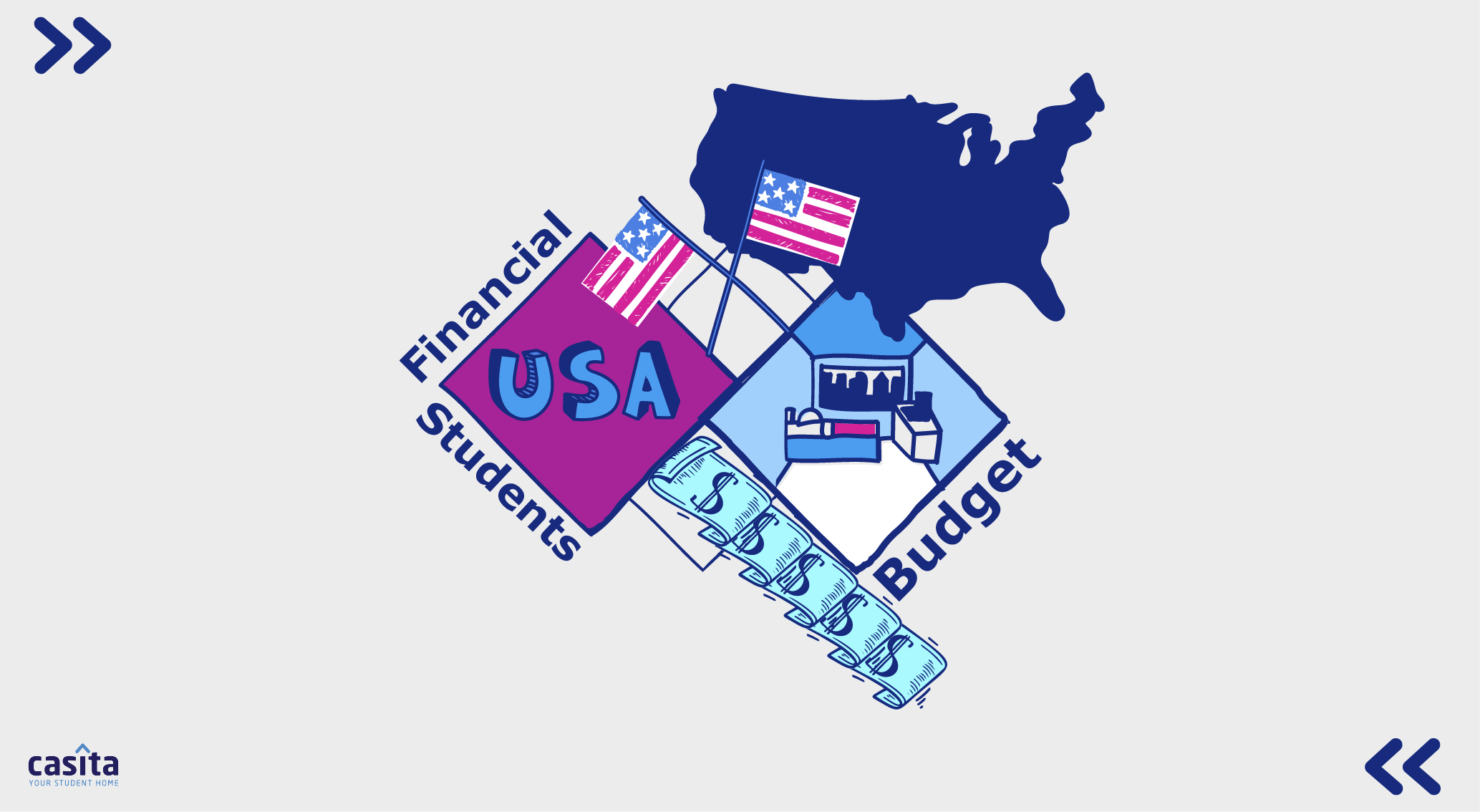Cost of living in the USA as an International Student
Student Finance
8 mins read
Share

Updated at: 16 December, 2024
Published at: 03 April, 2023
By Guest Contributor
Cost of living in the USA as an International Student
Student Finance
8 mins read

Updated at: 16 December, 2024
Published at: 03 April, 2023
By Guest Contributor
Share
From offering the finest education system to providing the best hands-on learning experience, USA continues to prove why it is the ideal study-abroad destination for international students. Over the years, multiple study-abroad aspirants have worked hard to get accepted at their dream universities in the USA.
While academic preparation for Study in USA is important, students should also consider the cost of living in the United States. Having enough funds to survive in the USA is necessary to enjoy a seamless living experience.
There are essential costs to which a study abroad aspirant should know. Read along to find the cost of living in the USA, and bonus information at the end of to help you manage your finances in the USA better.
Top Factors Contributing Towards Living Costs In USA
When calculating the expenses required to live in the USA, many factors contribute to the matter. Although the amounts can vary based on each student’s spending, there are three aspects which study abroad aspirants should pay attention to:
Costs of Living
Tuition Fees
Overview of living costs in the USA (per the state and university choice)
Let’s learn about each of them in detail below.

Costs of Living
When you move to a new country such as the USA, you should be aware of various expenses. As an international student, your average cost of living in the USA will be divided into five categories:
Accommodation
Food/Groceries
Healthcare
Transportation
Personal Expenses
Let’s elaborate on the above sub-categories of living expenses in the USA to get a better insight:
Accommodation
Before students arrive in the USA, they should be aware of the availability of their accommodation in the USA for Indian students. There are two types of accommodation for students to choose from:
On-Campus Housing
Off-Campus Housing
On-Campus Housing
On-campus housing refers to accommodations that an educational institution provides. Here, students can either share their rooms with multiple students or opt for private sharing accommodations, wherein they can share their rooms with another student. Choosing this housing plan in the initial stage is advised since international students are new to the country.
After living on campus for a year or two, students can go for the second housing plan, which is off-campus. Based on a university's choice, the housing plans can vary. Here is an overview:
University Name | On-Campus Housing Fee |
California Institute of Technology | $11,247/year |
University of Southern California | $17,731- $19,739/year |
Brown University | $9,650/year |
Yale University | $10,900/year |
Rice University | $10,200/year |

The on-campus housing pricing can also vary based on the type of the chosen educational institution, such as public or private universities. The on-campus housing price starts at $9,650/year, and based on your accommodation choice and facilities, it can go up to $17,940/year.
Off-Campus Housing
Off-campus housing refers to accommodations where students live outside their university/college campus. The reason for its popularity is that there is a wide range of lifestyle choices that students can choose from, such as:
Renting a single apartment.
Renting an apartment and sharing house space with another student.
Renting a room with a family in the USA.
Students who have a reference in the country can easily choose this housing plan since they have a constant guide. Apart from this, students can also research student accommodation providers like Casita.
International students who prefer off-campus housing can benefit from Casita. This student accommodation marketplace makes the process of finding private accommodations and student rooms simple. You just need to fill in some details such as your budget and the type of accommodation you’re looking for.
On the other hand, here is a pricing plan for off-campus accommodation to help you understand the difference between the two types of housing:
Type of Accommodation | Price |
2-bedroom rented apartment | $1,925/month |
Sharing room | $450- $1,424/month |
1-bedroom apartment | $500-$3500/month |
Here are a few quick tips to keep in mind before making your decision:
Sharing a room or a house is always cheaper than renting alone.
If you’re unsure, start with on-campus housing and slowly make your connections to move out.
Choose accommodation that caters to your basic needs, such as access to 1-time meals and being close to your university/college.
Check your budget before booking any accommodation.
Practice the art of saving money and always search for affordable options.
Food/Groceries
Living in a new country and getting your taste palette adjusted will take time. Most international students spend most of their money dining outside, leaving them with less money for the remaining month. It is better to understand how much you should spend on food and adjust your other living costs accordingly.
Food costs will vary based on your housing plan:
Dining Type | Cost |
On-campus housing food | $250- $560/month |
Off-campus housing food | $499-$690/month |
Restaurant Dining | $15-$688/month |
Based on the restaurant dining costs, you may have noticed that there are affordable restaurants that international students can visit. However, if you wish to cook by yourself, you can do so and go grocery shopping.
Groceries in the USA can be cheaper if you buy from local shops. Here is an example of a few average grocery costs based on a one-time purchase:
Groceries List | Cost |
Milk (0.25 litres regular) | $0.26 |
White Rice | $0.42 |
Eggs (2.40 g) | $0.82 |
Banana (1 kg) | $1.61 |
Bread (125 g) | $0.82 |
Healthcare
International students are required to have healthcare insurance, since the USA is an expensive country when it comes to seeking medical assistance.
For international students, most universities offer health insurance, which is calculated either separately or along their cost of living plan provided on their official website. However, students can avoid paying the health insurance as long as they prove they have availed of health insurance from another provider.
The cost of health insurance from USA universities ranges from $4,080 per year to $4,800 per year.
Transportation
One of the best ways to manage your living expenses in the USA is to use public transportation. The country offers multiple affordable public transportation options, such as buses, trains, and subways, that are budget-friendly for international students.
The transportation cost varies based on the type of transport. The cost can range anywhere between $300- $700/year. Here is an overview of the transportation costs:
Type of Transportation | Cost |
Monthly bus pass | $60- $119/month |
Taxi | Minimum $3.25/one-way |
Individual bus ticket | $0.98- $2.75/one-time |
Apart from this, students can also travel free if their university/college offers transportation. For example, Carnegie Mellon University, USA, provides buses for students that drop them inside the campus. You can enquire about the same from your choice of institution.
Also, international students can make use of student discounts when travelling in the USA. All you need is your student ID to be eligible for a student discount. Purchasing a student advantage card also gives you a lot of discounts when travelling, shopping, or dining in the country. It just costs $20/year.
Students are also advised to check with the local train transits to benefit from discounts. For example, New Jersey Transit offers a 25% discount for students who travel via bus and rail. You can even get discounts on your monthly passes.

Personal Expenses
Lastly, students will have other personal expenses when staying in any housing option. These expenses will vary from one student to another based on the accommodation type. Here are a few common examples of these expenses:
Expenses Type | Cost |
Electricity | $20- $150/month |
Study Materials | $75- $1,150/month |
Phone subscription | $50/month |
Internet | $15-$50/month |
Entertainment | $80- $100/month |
Other miscellaneous expenses | $85- $250/month |

Tuition Fees
Tuition Fees are another aspect that international students should consider when making their budget. Tuition fees in this country vary based on factors such as type of university and course undertaken. Here are the details:
Public and private universities in the US have seen the largest number of international students. While both universities are popular, most international students opt for public universities because they have significantly cheaper fees than private institutions and are more affordable. Here is the list of the US university fees for international students:
Type of University | Tuition Fees |
Public | Undergraduate- $39,000/year- $72,762/year Graduate- $32,000/year- $47,974/year |
Private | Undergraduate- $52,000/year- $66,500/year Graduate- $57,000/year- $99,982/year |
The above information is an estimate of a few universities chosen. It is advised that students check the university's official website to access exact figures for their tuition fees.
An educational institution's tuition fees aren’t limited to the type of university/colleges alone. Based on the course choice, the study cost in the USA for Indian students can vary, as shown below:
Courses | Fees |
MBBS | $47,700- $325,000/year |
Engineering | $13,239- $75,000/year |
Business | $15,000- $80,460/year |
Law | $22,000- $46,000/year |
Finance | $32,375- $86,522/year |
MBA | $45,000- $80,000/year |
PhD | $20,000- $58,000/year |
The above information has been shared by combining fees from both private and public universities. Students should visit the universities/college's official website to learn about the tuition fee details based on their course choice.

Living Cost in the USA: Overview based on USA States & Universities
Apart from the above, the living expenses in the USA for international students can also change based on choices made in two things, the USA state they wish to live in and the university. It is always better to decide where to live and to study before planning your finances. Here are the details for both categories:
Living Cost in the USA States
The USA has multiple states. If you opt for the central city or the popular areas, the living cost will increase simultaneously. Here are the average expenses in USA states:
States | Monthly Living Cost |
New York | $2500- $3500 |
California | $3500- $4500 |
Boston | $2900- $3500 |
Atlanta | $1800- $2200 |
Texas | $2400- $3800 |
New Orleans | $1100-$2500 |
Chicago | $1300- $2500 |
Dallas | $1000- $2000 |
Living Cost as per Universities/Colleges
The living cost also varies based on the university/college. Almost all the living costs shared by each university cover the total living cost, including tuition fees, accommodations, and other categories covered here. Here are a few examples:
University Name | Living Cost |
California Institute of Technology | $60,000- 87,000/year |
MIT | $31,395- $41,499/year + tax |
Cornell University | $74,394- $83,296/year |
University of California, Berkeley | $57,000- $70,000/year |
Brown University | $65,000- $88,000/year |
University of Texas, Austin | $39,912- $65,268/year |
Top Tips To Manage Finances in the USA As An International Student
Here is the bonus information which we’ve promised you earlier.
As you’ve known by now, there are various types of expenses which you need to pay attention to while living in the USA. However, managing these expenses can become easy if you go for a few alternatives this country offers and strategize your expenses in advance.
Here are a few tips you can follow when preparing your finances:
1. Apply for a scholarship:
One of the best ways to manage your finances is to apply for a scholarship. The USA offers multiple scholarship opportunities for students based on their academic performance. The perks of these scholarships are that they offer funding options such as covering US university fees for international students or living expenses. Here are a few scholarships you should check out:
Scholarship Name | Applicable For | Amount/Covers |
Fullbright Scholarships | Students who wish to pursue graduate programs at any USA university | Covers tuition fees and living expenses, healthcare, airfare, and accommodation fees. |
Stanford University Scholarships | Students who wish to pursue graduate programs at Stanford University | Covers tuition fees, living expenses, and travel costs. |
University of New Haven Scholarship | Students who wish to pursue a Masters program at University of New Haven | Offers 75% tuition coverage and hourly payments |
2. Work part-time
International students can manage their living expenses better by working part-time jobs. USA allows students to work up to 20 hours per week. Students can work in various places, make more money, and have valuable work experience during their academic period. Additionally, you can work from home and maybe record your daily life for Vlogs and so on for some extra cash. Use video editor for this.
3. Choose the affordable transportation
Multiple affordable transportation options can support your finances while living in the USA. Taking the subway to your university/college can be cheaper. Buying groceries from local shops and cooking at home will also reduce your food expenses. Also, using student discounts to travel, shop, or dine at restaurants is a great way to save money. Students should see such options and work their way to managing their finances during their stay.
4. Explore USA to learn about its surroundings
It is always better to explore a country to learn more about it. Most international students rely on their friends when visiting eateries or shopping. When you explore the country independently, you can find cheaper alternatives to your spending decisions.
The USA has been on top of the list of international students for many years. Now that you know the costs of studying in the USA, it’s time to make to your dream country. Since you’re getting started, it will always help if you have a study abroad expert who can guide you through the process. Get started by booking your first free counselling session today!
Student Finance
By Guest Contributor
Share
Student Finance
Updated at:
Published at:
By Guest Contributor
Share


